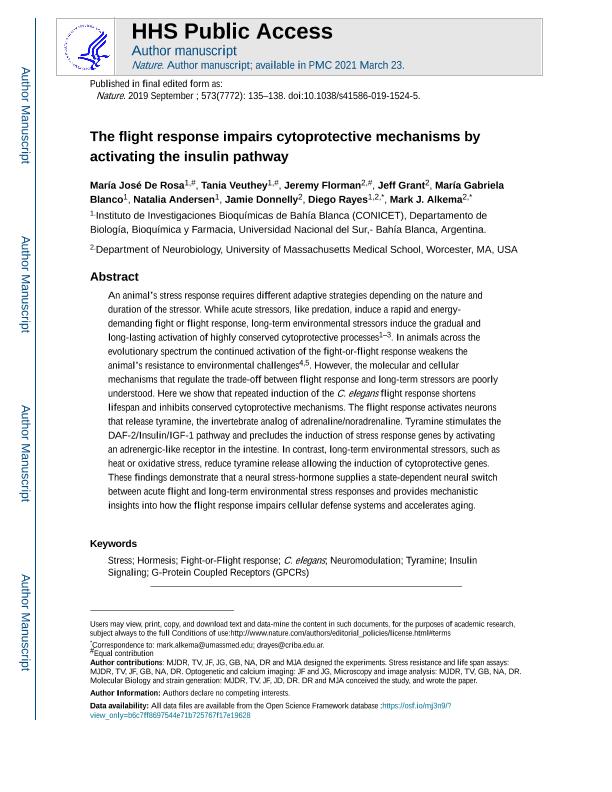Artículo
The flight response impairs cytoprotective mechanisms by activating the insulin pathway
de Rosa, Maria Jose ; Veuthey, Tania Vanesa
; Veuthey, Tania Vanesa ; Florman, Jeremy; Grant, Jeff; Blanco, Maria Gabriela
; Florman, Jeremy; Grant, Jeff; Blanco, Maria Gabriela ; Andersen, Natalia Denise
; Andersen, Natalia Denise ; Donnelly, Jamie; Rayes, Diego Hernán
; Donnelly, Jamie; Rayes, Diego Hernán ; Alkema, Mark
; Alkema, Mark
 ; Veuthey, Tania Vanesa
; Veuthey, Tania Vanesa ; Florman, Jeremy; Grant, Jeff; Blanco, Maria Gabriela
; Florman, Jeremy; Grant, Jeff; Blanco, Maria Gabriela ; Andersen, Natalia Denise
; Andersen, Natalia Denise ; Donnelly, Jamie; Rayes, Diego Hernán
; Donnelly, Jamie; Rayes, Diego Hernán ; Alkema, Mark
; Alkema, Mark
Fecha de publicación:
28/08/2019
Editorial:
Nature Publishing Group
Revista:
Nature
ISSN:
0028-0836
Idioma:
Inglés
Tipo de recurso:
Artículo publicado
Clasificación temática:
Resumen
An animal’s stress response requires different adaptive strategies depending on the nature and duration of the stressor. Whereas acute stressors, such as predation, induce a rapid and energy-demanding fight-or-flight response, long-term environmental stressors induce the gradual and long-lasting activation of highly conserved cytoprotective processes1,2,3. In animals across the evolutionary spectrum, continued activation of the fight-or-flight response weakens the animal’s resistance to environmental challenges4,5. However, the molecular and cellular mechanisms that regulate the trade-off between the flight response and long-term stressors are poorly understood. Here we show that repeated induction of the flight response in Caenorhabditis elegans shortens lifespan and inhibits conserved cytoprotective mechanisms. The flight response activates neurons that release tyramine, an invertebrate analogue of adrenaline and noradrenaline. Tyramine stimulates the insulin–IGF-1 signalling (IIS) pathway and precludes the induction of stress response genes by activating an adrenergic-like receptor in the intestine. By contrast, long-term environmental stressors, such as heat or oxidative stress, reduce tyramine release and thereby allow the induction of cytoprotective genes. These findings demonstrate that a neural stress hormone supplies a state-dependent neural switch between acute flight and long-term environmental stress responses and provides mechanistic insights into how the flight response impairs cellular defence systems and accelerates ageing.
Palabras clave:
CAENORHABDITIS ELEGANS
,
TYRAMINE
,
ACUTE STRESS RESPONSE
,
AGEING
Archivos asociados
Licencia
Identificadores
Colecciones
Articulos(INIBIBB)
Articulos de INST.DE INVEST.BIOQUIMICAS BAHIA BLANCA (I)
Articulos de INST.DE INVEST.BIOQUIMICAS BAHIA BLANCA (I)
Citación
de Rosa, Maria Jose; Veuthey, Tania Vanesa; Florman, Jeremy; Grant, Jeff; Blanco, Maria Gabriela; et al.; The flight response impairs cytoprotective mechanisms by activating the insulin pathway; Nature Publishing Group; Nature; 573; 7772; 28-8-2019; 135-138
Compartir
Altmétricas



